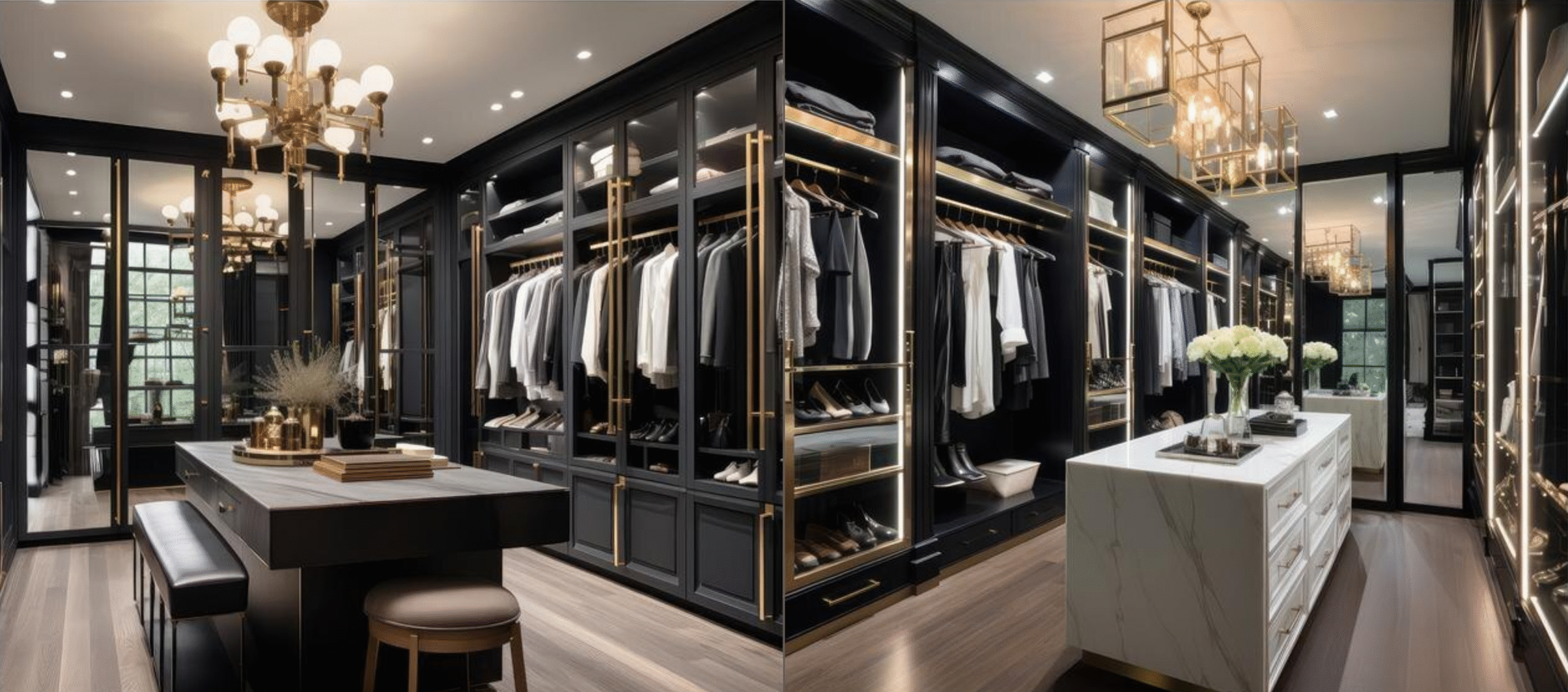As modern home design increasingly gravitates toward luxury and refined aesthetics, there’s been a growing focus on infusing spaces with both opulence and personal identity. In this pursuit, the walk-in closet has emerged as one of the most essential features in today’s interior architecture. No longer a shy corner tucked inside the bedroom, it has evolved into a space in its own right—one that embodies elegance, organization, and an appreciation for daily details.
The closet room, often referred to as a “dressing room” or “closet room,” is now considered a fundamental element in the floor plans of modern homes—whether in grand villas or intelligently designed apartments. And the reason is simple: we don’t just wear our clothes—we live with them. We choose them to express ourselves, organize them to ease our rushed mornings, and keep them as a visual archive of our lifestyle.
This space isn’t an unnecessary luxury—it’s a smart investment in daily comfort. It allows us to organize our clothes, shoes, and accessories in a way that makes everything accessible, saving us time and preventing clutter. It’s where chaos transforms into order, and disarray turns into sophistication.
But beyond its practical function lies a deeper aesthetic value. A walk-in closet can reflect your taste in the most personal way. You might opt for a classic style with warm wooden finishes, or lean into modern minimalism with clean lines and neutral tones. It could be open to the bedroom or entirely separate, enhanced with special lighting, mirrors, and even a cozy corner for hairstyling or trying on different looks.
Today’s dressing room is no longer just a place to store what we wear—it’s part of our lifestyle. It’s a space that mirrors who we are, caters to our everyday needs, and brings a quiet sense of luxury and refined organization to our homes
Open or Closed? A Comparison of Closet Styles and the Secrets of Smart Space Planning
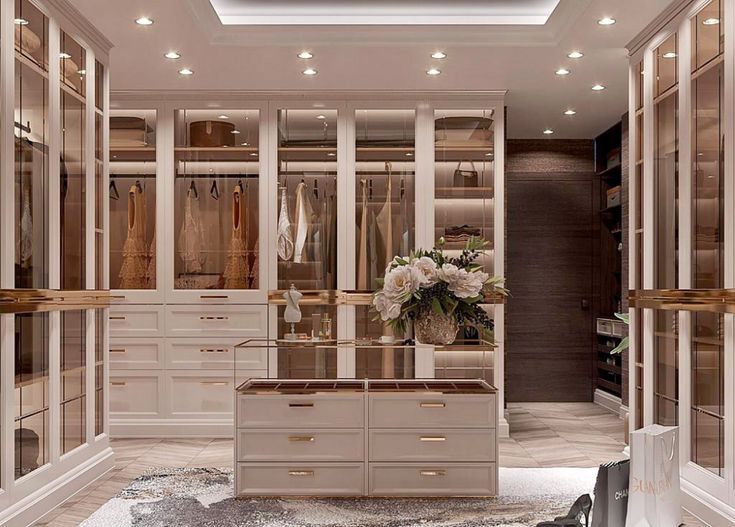
When designing a walk-in closet, one essential question often defines the character of the space: should it be open or closed?
The answer might seem straightforward at first, but in reality, it hinges on a delicate balance between personal taste, family needs, and the physical dimensions of the room.
Open closets, sometimes referred to as “concealed open wardrobes,” offer a sense of spaciousness and visual continuity with adjacent rooms. They’re the go-to choice for lovers of minimalist or modern design—those who view clothing and accessories not just as belongings, but as part of the room’s aesthetic identity. However, this style requires a high level of discipline and tidiness, since everything is on full display.
On the other hand, closed closets provide greater privacy and conceal any temporary clutter or visual noise behind elegant doors. This makes them a practical choice for families or those who prefer a more classic, luxurious look. They also allow for more intricate customization and versatile storage solutions—without worrying about how the interior might affect the overall design harmony.
In both cases, however, smart planning remains the foundation. Designing the perfect closet goes far beyond just measuring cabinet widths or placing lights. It’s about how each centimeter is utilized to strike the ideal balance between function and style. From hidden shelving and rotating corner units to integrated lighting and designated accessory zones—every tiny detail contributes to a smarter, more beautiful space
Your Guide to Choosing the Best Closet Layout Based on Your Home’s Space
A walk-in closet doesn’t need to be massive to be luxurious or functional. It’s not the size, but the shape and smart design that truly make a difference. Here are four essential layout styles that cater to various needs—from compact apartments to expansive villas:
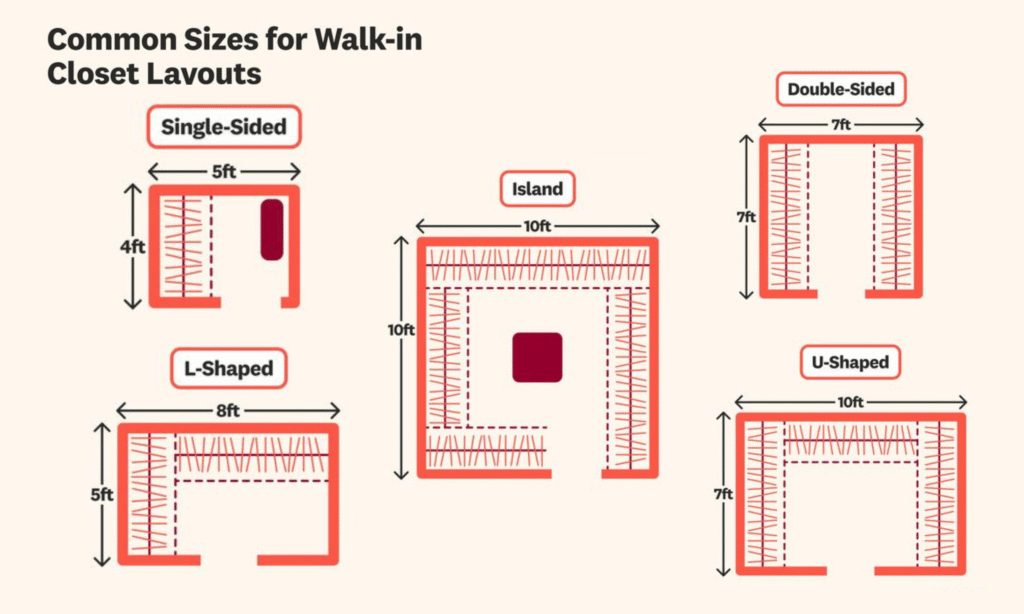
1. U-Shaped Closet
This layout is ideal for relatively spacious areas. It utilizes three full walls, offering exceptional storage space and seamless organization. The U-shape creates a sense of richness and cohesion, while allowing easy access to every item without visual clutter. It opens up endless possibilities—one wall can be dedicated to a sleek vanity with a softly lit LED mirror, while the center space can accommodate a mid-sized table or even a plush chaise lounge to heighten the sense of luxury. Lighting plays a key role here—from soft overhead lights to concealed lighting inside the cabinets. This design is like having your very own private dressing suite.
2. L-Shaped Closet
If you have a cozy corner next to your bedroom, the L-shape is a clever solution that strikes the perfect balance between space optimization and movement flow. One side can feature tall storage units, while the shorter wall can host a full-length mirror or a small vanity nook with an elegant chair. A low cabinet placed in the corner is perfect for storing accessories or handbags. This layout suits “smart corners” perfectly and offers a graceful, flowing aesthetic. Padded stools or rounded poufs work beautifully here, providing a comfortable seat without creating visual clutter.
3. Linear Closet (Single Wall)
For limited spaces or small apartments, the linear layout is an ideal, space-saving solution. With a single streamlined wall of built-in closets, everything can be neatly organized without sacrificing elegance. When combined with sliding doors and mirrors, it blends seamlessly into the room, feeling like an integral part of the decor rather than a bulky wardrobe.
Simple yet highly effective, this layout can become a statement piece with the right design touches. Full-wall mirrors—mounted or integrated into the closet doors—can make the space feel larger and brighter. If there’s a small adjacent area, you can even add a compact vanity with a mirror that reflects natural light. Seating here tends to be small, functional, and often foldable, making it ideal for tight spaces.
4. Independent Walk-in Closet
The purest form of luxury. An entirely separate room dedicated to clothing and accessories, this design allows for unlimited customization and zoning. From specialized lighting to seating areas and even a beauty station, a dedicated walk-in closet is a dream within reach—even in medium-sized homes, if planned properly.
This layout offers full flexibility. The room can be divided into distinct areas: one for wardrobes, another for the vanity, and perhaps a dedicated corner for seating. Full-length mirrors, a complete makeup table, and an upholstered luxury chair—or even a classic-style chaise lounge—are all viable options. A statement rug or a hanging chandelier can also add a dramatic flair that reflects your personality and elevates the ambiance.
In all these designs, smart lighting cannot be overlooked: soft ambient lighting within shelves, mirrors with built-in lights, and motion-sensor switches make daily use far more intuitive and enjoyable.
Ultimately, choosing the perfect closet layout isn’t just about space—it’s about your lifestyle, daily routines, and personal sense of order. A well-designed closet knows how to spotlight elegance, even in the simplest of corners
Materials & Finishes in Closet Design: How to Choose Between Wood, Glass, and Metallic Touches

When it comes to designing a walk-in closet, choosing the right materials and finishes is not merely a stylistic decision—it’s also a practical one that influences the ambience, lighting, and durability of the space. These elements are what give the room its soul, that lasting first impression that defines the entire experience.
Wood remains the beloved classic. It’s warm, elegant, and visually comforting. Natural wood tones create a cozy, rustic atmosphere, while darker stains evoke a quiet sense of luxury. Popular types like oak, walnut, and beech offer rich textures and a subtle sheen. Paired with simple handles and clean lines, wood is ideal for those who seek a timeless, traditional elegance that lasts.
On the other end of the spectrum, glass is the go-to for modern design lovers who crave light, clarity, and openness. Glass-front wardrobes create a sense of spaciousness—especially useful in smaller rooms—and enhance lighting by reflecting it throughout the space. There are several appealing options to choose from:
- Clear glass: Perfect for showcasing your wardrobe in an artistic way, but it does require constant tidiness.
- Frosted or etched glass: Strikes a great balance between privacy and sophistication.
- Tinted or colored glass: Shades of grey, smoked black, or even metallic hues like bronze or gold bring a dramatic flair and define the room’s mood.
When we speak of metallic finishes, we’re not just referring to raw metals, but also to the gleaming accents that enhance edges, handles, or even serve as decorative overlays on cabinet doors. Think matte gold, smoked bronze, or polished nickel—each capable of turning a simple closet into a distinctive design statement.
But above all, the real magic lies in harmony. Avoid going all-gloss or all-matte. Instead, mix and match wisely. A warm wood paired with frosted glass, or smoky glass framed with golden metallic handles, or even glass-front panels backed by textured wood—these combinations add depth, personality, and refined uniqueness.
In the end, materials are more than just surfaces. They’re the language your closet speaks—whispering your taste, reflecting your lifestyle, and defining your daily experience.
The Art of Lighting in Walk-in Closets: How to Choose the Perfect Illumination for Every Corner
Lighting in a walk-in closet isn’t just a decorative detail—it’s a foundational element that enhances both functionality and beauty. The right lighting can transform your closet into a personal boutique, giving every piece of clothing or accessory its moment to shine.
To be truly effective, closet lighting should be thoughtfully layered across four key levels:
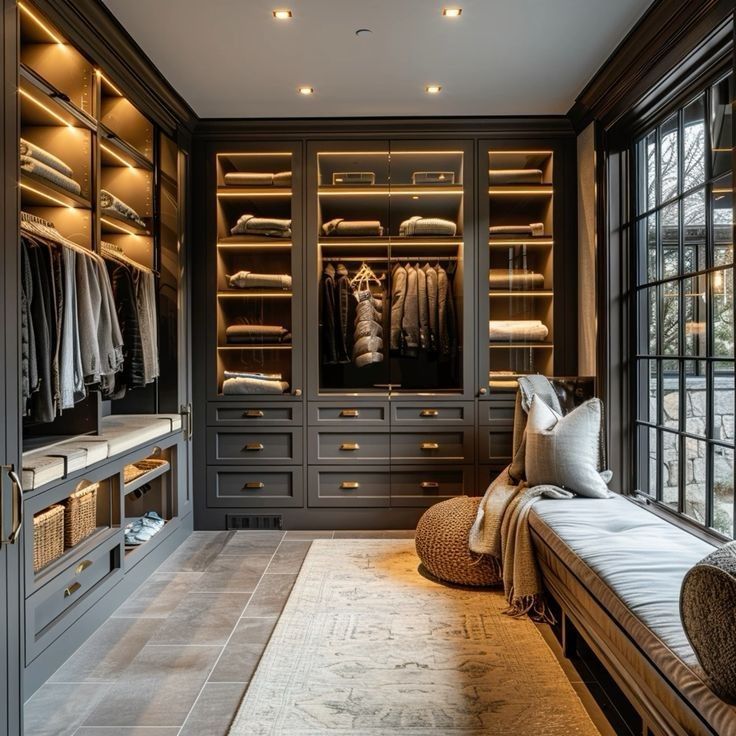
1. Ambient Lighting:
This is the primary light source that fills the room and sets a welcoming atmosphere from the very first step inside. It typically consists of ceiling-mounted spotlights or concealed LED strips embedded in false ceilings. A modern chandelier can also act as a striking design element that adds a dramatic flair. The trick lies in choosing the right light color: warm white creates a sense of luxury and intimacy, while cool white lends a crisp, contemporary feel.
2. Task Lighting Inside Cabinets:
There’s something delightfully practical about opening your closet doors to find every shelf and drawer perfectly lit. Task lighting is often motion-activated, turning on when you open a door and switching off automatically. LED stripsplaced along the sides or at the top of shelves provide focused light, helping you locate items without illuminating the entire room.
3. Mirror Lighting:
Whether you have a full-length mirror or a vanity mirror, integrated lighting around it is essential. It’s not just about visibility for dressing or makeup—it adds a touch of elegance and seamlessness to the design. Mirrors with built-in LED lighting are especially favored for their clean, minimalist look and soft, even glow.
4. Accent & Shelf Lighting:
This type of lighting highlights your most cherished pieces—like a treasured watch, a designer handbag, or a pair of statement shoes. Backlit or under-shelf LED strips create a gallery-like effect, turning your closet into a curated display. Warm golden tones can also be used to add depth and visual richness to the showcased items.
In the end, lighting isn’t just about illumination—it’s the maestro orchestrating a symphony of style and balancewithin your closet. The real secret lies in blending all four types harmoniously, so that each area feels distinct, intentional, and beautifully lit
Mirrors in Walk-in Closets: Double the Elegance, Endless Visual Beauty
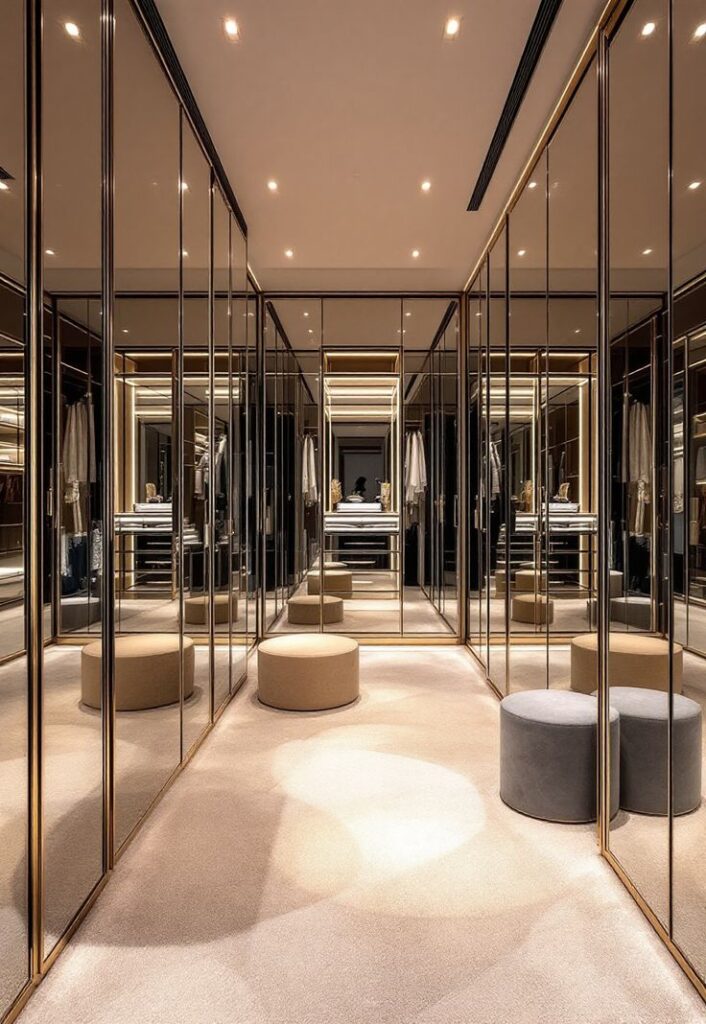
Mirrors are far more than tools for checking our reflection—they are a design element that masterfully enhances visual impact. In walk-in closets especially, mirrors play a vital dual role: they offer moments of self-reflection and effortlessly amplify the sense of space, even in more compact rooms.
From an aesthetic standpoint, mirrors add a layer of elegance and sophistication. Whether you opt for a full-length standing mirror, a wall-mounted mirror integrated into a closet door, or a lighted mirror above a vanity, it instantly becomes a functional design statement. Thin metallic frames or frameless styles enhance a modern, sleek look, while carved wood or ornate frames bring in a warm, classic feel.
Functionally, mirrors are a designer’s secret weapon for visually expanding a room. When placed strategically—such as opposite a natural light source or at the end of a narrow hallway—they reflect light and create a sense of depth, making the space feel twice as large. For example, a floor-to-ceiling mirror at the far end of a linear closet can make the room appear significantly longer.
Having a mirror in your closet also elevates your daily routine—from planning your outfit to testing accessories or tweaking your hairstyle at the last moment. That’s why choosing a mirror with high-quality reflection and optimal lighting is an investment not just in style, but in comfort and confidence.
Ultimately, mirrors in a walk-in closet aren’t just a practical necessity—they’re a clever design tool, holding within their reflective surface the secrets of light, taste, and that all-important first impression.
Your Personal Corner in the Closet: The Perfect Beauty and Makeup Nook

In the world of interior design, it’s often the smallest moments that make the biggest difference in your daily experience. And a makeup corner within your walk-in closet is one of those delightful details that brings together privacy, comfort, and beauty. It’s not just a spot to apply cosmetics—it’s a dedicated space just for you, where light meets reflection, and details flow with warmth and intention.
The first thing to consider is smart storage.
Shallow and deep drawers alike are perfect for organizing cosmetics—from your everyday essentials to special occasion products. These drawers can be divided using elegant acrylic organizers to assign space for lipstick, foundation, or even tiny accessories, giving you easy access to everything without the chaos.
Open shelves are another must-have, ideal for displaying perfumes, makeup brushes, and skincare products. These not only add a visual appeal, but also serve as a reminder of the beautiful items you own—like your very own curated beauty gallery. Incorporating clear glass or acrylic elements enhances the sense of purity and organization, allowing everything to shine without feeling cluttered.
And because lighting is where the real magic happens, the lighted mirror must be the star of this setup. Choose a mirror framed with soft, neutral LED lighting that doesn’t distort colors or cast harsh shadows. Many modern mirrors now offer adjustable lighting modes—daylight, warm, and cool tones—to match any moment, whether you’re getting ready for a busy workday or a glamorous evening out.
Finally, don’t forget your personal touch: a velvet stool in your favorite color, a clear vase with fresh flowers, or a scented candle to add a sensory dimension to your routine.
This may be a makeup corner inside your closet—but in truth, it’s so much more. It’s your personal sanctuary, the place where your confidence begins each and every morning
Male’s vs. Female’s Walk-in Closets: A Design Dialogue Between Function and Sophisticated Detail
In the world of interior design, some spaces are crafted with personal identity at their core—and the walk-in closet is one of the most intimate among them. While men and women share the need for organization and aesthetic appeal, the design nuances differ intelligently, reflecting varying priorities, styles, and rhythms of daily life.
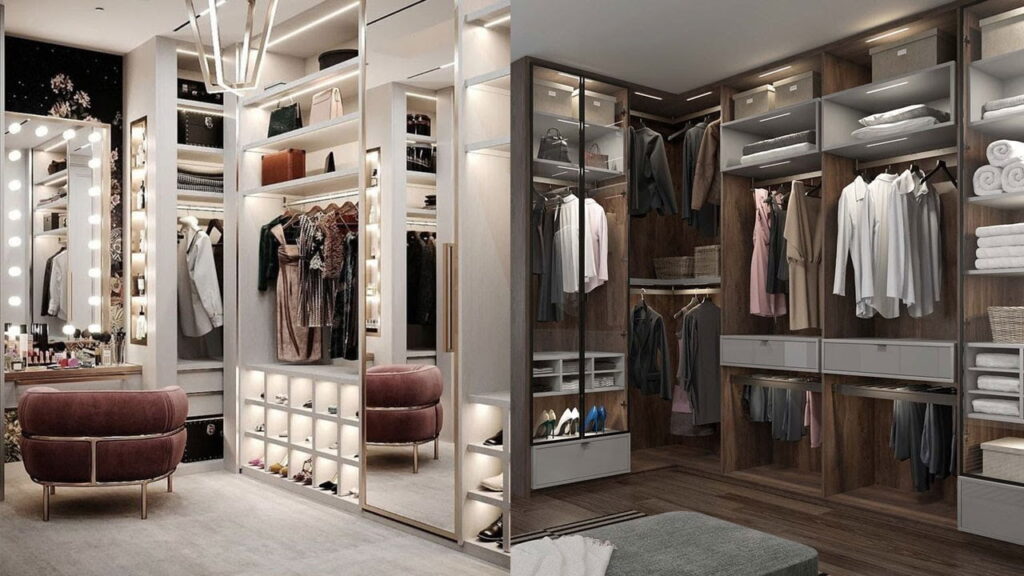
Men’s closets often lean toward practical simplicity and streamlined functionality. Preferred color palettes are typically neutral—think charcoal gray, navy, deep brown, or classic black—enhanced by touches of leather or wood for added depth and elegance. These closets are structured around essentials: dedicated sections for suits, shirts, and formal shoes, as well as a special spot for watches or ties. Shelving is wide and neatly arranged, while shoe storage is often hidden behind closed drawers or boxes to maintain a clean, uncluttered look.
Lighting in men’s closets is usually warm and slightly subdued, creating a relaxed atmosphere. Mirrors are used more discreetly—often limited to a single full-length mirror tucked into a corner. As for furniture, it’s strictly functional: a small leather chair or a low side table for essentials like wallets, watches, and sunglasses.
On the other hand, women’s closets are a world of delicate details and quiet luxury. The color schemes vary from soft whites and creams to blush pinks and muted golds, creating an environment that is both bright and inviting. These closets feature clearly defined zones for different categories: long dresses, accessories, handbags, and a diverse range of shoes.
A major focus is placed on the beauty and self-care area, complete with a lighted mirror and an elegant vanity setup. The furniture leans towards softness and charm: a velvet chair, a petite chaise lounge, or even a plush rug that adds a cozy layer underfoot. Open shelving is often used to artfully display perfumes and jewelry—like a private boutique within the home.
Despite these differences, the core principle of closet design remains the same: every detail should enhance the user’s experience. With thoughtful planning and a personalized approach to every corner, a walk-in closet becomes a reflection of identity, a space that mirrors its owner just as clearly as their personal style does.
Your Closet… Your Reflection: How to Design a Space That Mirrors Your Style and Personality
In interior design, the walk-in closet stands out as a deeply personal space, crafted not just around aesthetic or architectural norms, but around your daily habits, personal taste, and lifestyle. It’s far more than an expanded wardrobe—it’s a reflection of who you are, conveyed through your choice of colors, materials, and organization. And because every personality is different, so are the design styles that speak to them. Here’s how each style can match a certain aesthetic, wardrobe size, and way of living:
1. Classic Style – For Those Who Value Order and Prestige
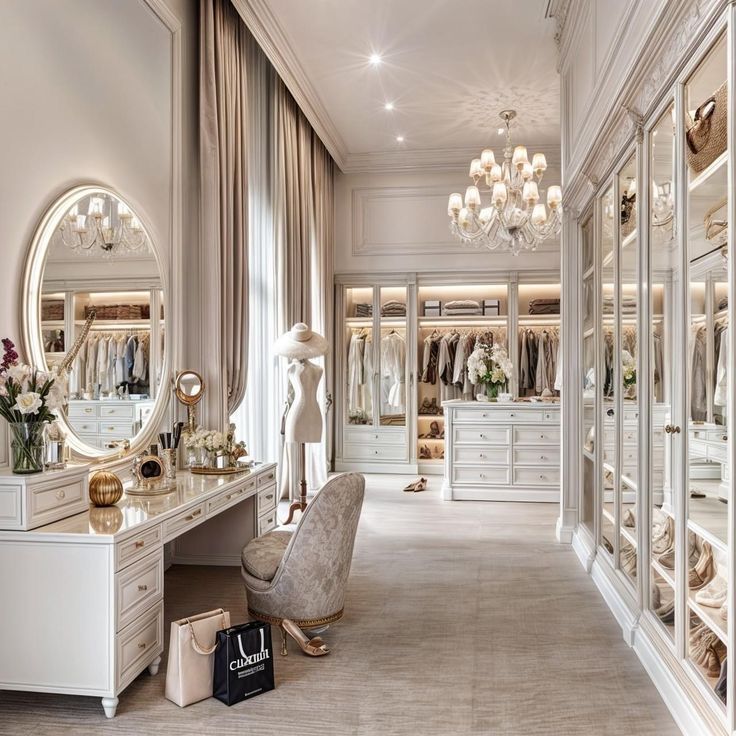
If you lean toward timeless elegance and traditional sophistication, the classic style is your perfect match. This design often features rich wooden cabinetry, in shades like walnut or mahogany, paired with carved gold or bronze handles. It’s ideal for those with a large collection of formalwear: suits, gowns, and polished leather shoes. Allocate generous space for long garments and include plush, velvet-lined drawers for accessories. Complete the look with a decorative framed mirror and a luxurious leather chair to elevate the ambiance.
2. Modern Style – For Lovers of Practical Elegance
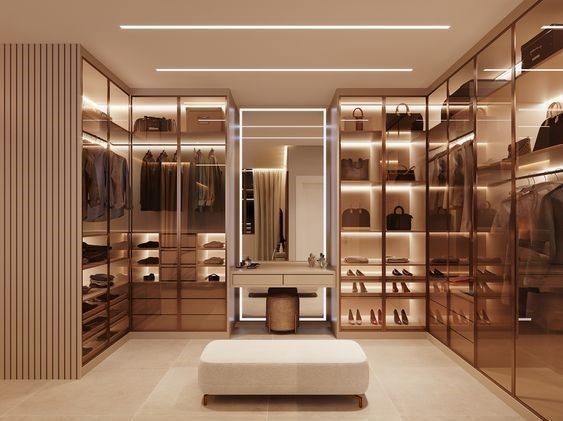
Perfect for the dynamic, modern individual who appreciates sleek beauty and smart functionality. Think clean lines, neutral tones (gray, white, black), and carefully planned storage. Glossy surfaces blend effortlessly with clear or frosted glass panels, while frameless mirrors and LED lighting add a futuristic touch. This style suits people with a versatile wardrobe and a fast-paced lifestyle. Furniture is minimal yet stylish—a monochromatic chair or soft leather bench is often all you need.
3. Minimalist Style – For Devotees of Clear, Intentional Simplicity
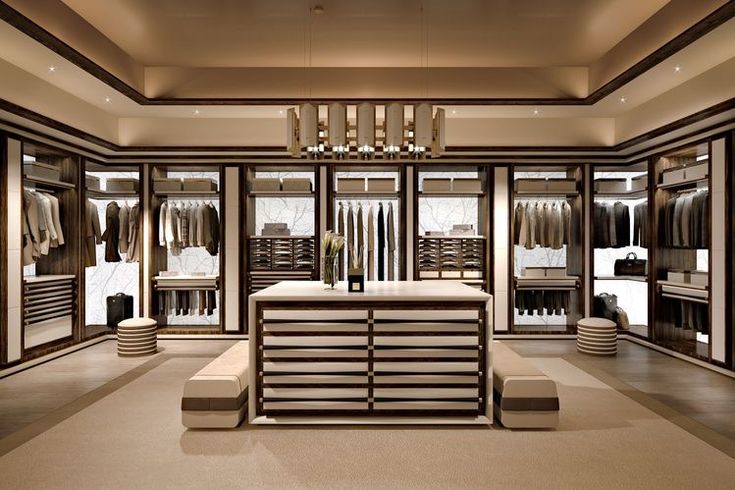
If you favor clarity over clutter and own fewer, high-quality pieces, minimalism is your go-to. The philosophy here is clear: “Less is more.” White, light gray, and natural light-toned wood dominate the palette. Cabinets are seamlessly built into the walls, often without visible handles. Lighting is soft and evenly distributed, and the vanity is compact and functional, with minimal decor. One key piece of furniture is enough—an acrylic chair or neutral leather stool will do just fine.
4. Glam Style – For Those Who Live and Breathe Luxury
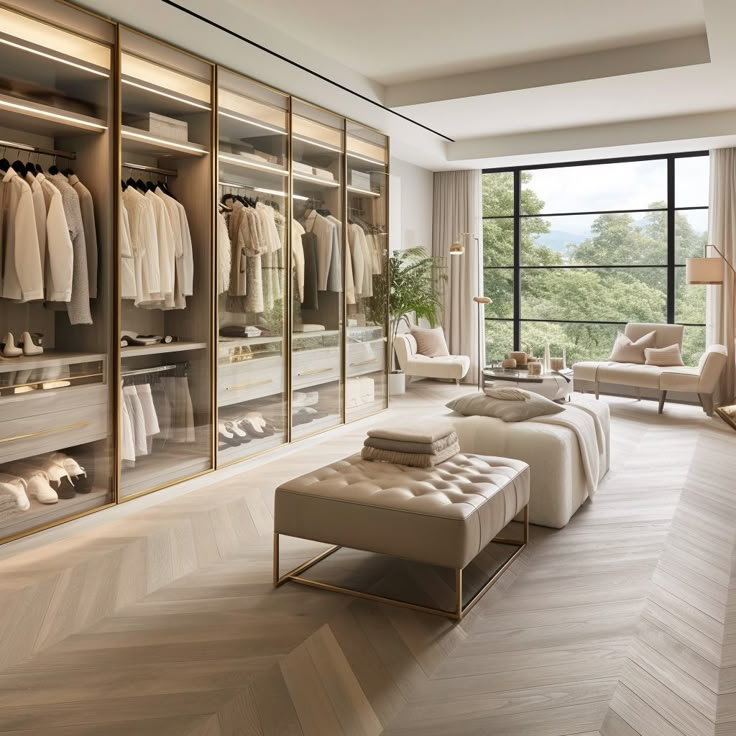
There’s no room for understatement here—luxury is the language. Rich tones like velvety beige, rose gold, or metallic gray set the mood, with glossy or glass cabinet fronts illuminated from within. Perfumes are artfully arranged on a designer tabletop, and a mirror framed in gold or LED lights adds a cinematic vibe. This style is perfect for anyone with an extensive collection of accessories, jewelry, and glamorous evening wear. A centerpiece chaise lounge or marble table is a must for that final dramatic flourish.
5. Industrial Style – For the Bold and Unapologetically Real
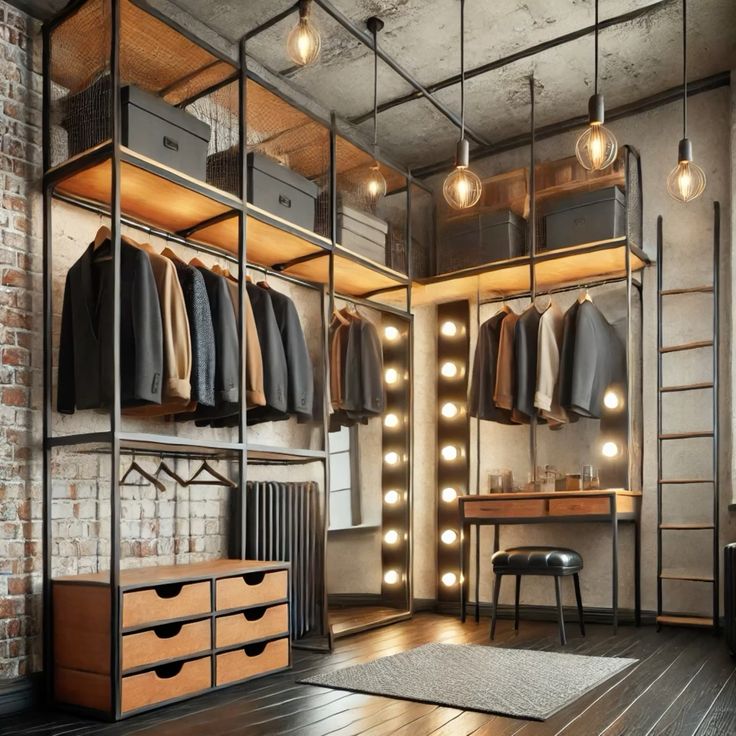
If you gravitate toward rugged textures and raw finishes, this style is a bold reflection of your taste. Think exposed walls, metal piping, matte gray or steel-colored cabinetry, and dark wooden floors. Lighting ranges from hanging metal pendants to focused spotlights. This design suits people who own durable, layered clothing—like denim, flannel, boots, and leather jackets. Storage is largely open, requiring consistent tidiness, and is best organized with metal or wooden crates for an authentic touch.
6. Bohemian Style – For Those Who See Elegance in Creative Chaos
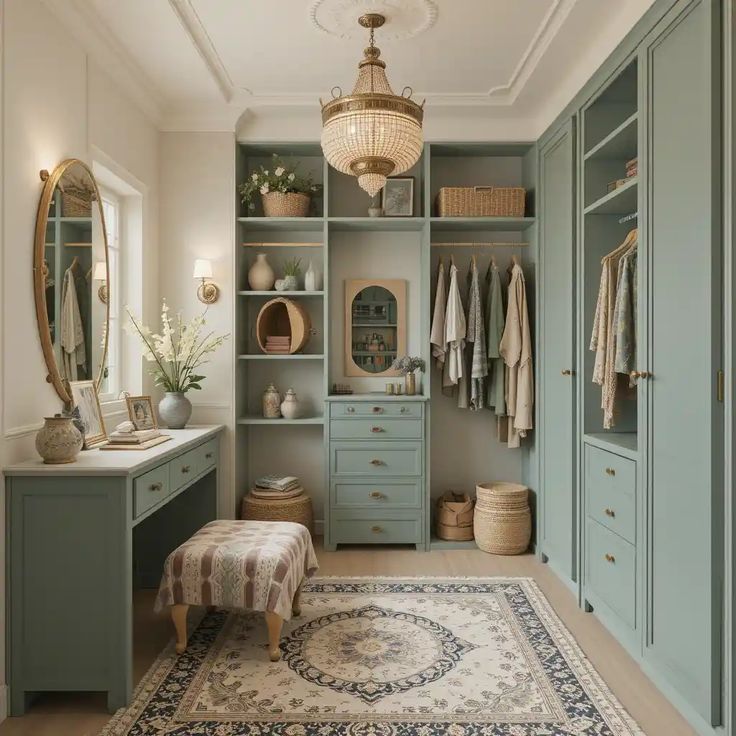
Boho style is made for the free spirit who sees a story in every piece and meaning in every color. Your closet becomes more of a creative sanctuary: warm hues, vintage rugs, woven baskets, and rough-hewn wooden cabinetry. Clothing is diverse and expressive—long embroidered dresses, scarves, hats—so the space should include open shelving and long hanging sections. The makeup nook feels like a charming old tale, complete with a vintage-framed mirror and a handwoven seat
Common Mistakes in Closet Design… and the Small Details That Make a Big Difference
Designing a walk-in closet is a beautiful dream—but one that can quickly turn into a source of frustration if not approached with practical thinking and careful planning. Some mistakes are surprisingly common, even in the most stylish closets. They may not appear in photos, but they become evident in daily use. Here are a few of the most frequent pitfalls, along with smart, actionable tips to avoid them:

1. Underestimating True Storage Needs
Many people design their closet based on how it looks rather than how it functions. They opt for elegant cabinetry that ends up holding only half of their actual wardrobe.
The solution?
Start by taking a full inventory of your clothing. How many long garments do you own? How many pants, bags, or shoes? Without this awareness, you might create a beautiful space that simply doesn’t work. Don’t forget to account for future growth, especially with seasonal items.
2. Forgetting to Include Space for Long Garments
A common oversight is failing to allocate space for long items like coats, gowns, abayas, or formalwear. The result? They get folded and damaged or end up awkwardly stored.
The solution?
Always dedicate at least one full-height section for hanging long pieces. Ideally, place it near a mirror for convenience.
3. Neglecting Purpose-Built Drawers
Drawers may seem like a generic solution, but poorly planned drawers quickly lose their utility. It’s impractical to toss jewelry, scarves, belts, and cosmetics all into one.
The solution?
Segment drawers by function: one for accessories, another for socks, a third for undergarments, and perhaps shallow drawers for contact lenses or perfumes. Use acrylic or fabric dividers to keep everything neat and accessible.
4. Poor Internal Lighting
Nothing ruins a closet experience like bad lighting. Whether too dim or misplaced, it leads to difficulty seeing colors, distinguishing garments, and using the space comfortably.
The solution?
Incorporate multiple layers of lighting: ambient lighting for the whole room, task lighting inside the cabinets, and focused lighting around mirrors. Be sure to choose bulbs that don’t distort fabric colors—opt for warm or natural white, depending on your design theme.
5. Ill-Considered Closet Doors
Closet doors may seem like a small detail, but they heavily impact ease of movement. Doors that open inward can block your path, while clear doors reveal clutter if organization isn’t perfect.
The solution?
Think about your needs: sliding doors to save space, opaque doors for privacy, or glass doors if you love to display your collection. Choose what complements both your lifestyle and your organization habits.
6. Ignoring Future Flexibility
Some closets are designed too rigidly, leaving little room for growth or changes. A year down the line, you may realize you need more shelves or extra hanging space.
The solution?
Invest in modular or adjustable storage systems, such as moveable shelves and expandable units that can adapt as your wardrobe evolves.
7. Forgetting to Include Seating or a Comfort Corner
A seating spot is often overlooked—but it’s incredibly useful. A small chair, pouf, or bench makes it easier to try on shoes, lay out outfits, or simply take a quiet moment to start your day.
The solution?
Even in small spaces, carve out a cozy corner with an elegant seat that matches the style of your closet. It’s a small touch that makes a big difference.
In the end, the perfect walk-in closet isn’t measured by size or luxury alone, but by how well it aligns with your everyday life. Every small mistake is avoidable with smart design, turning your closet into your personal assistant each morning—not an added stress in your home.
